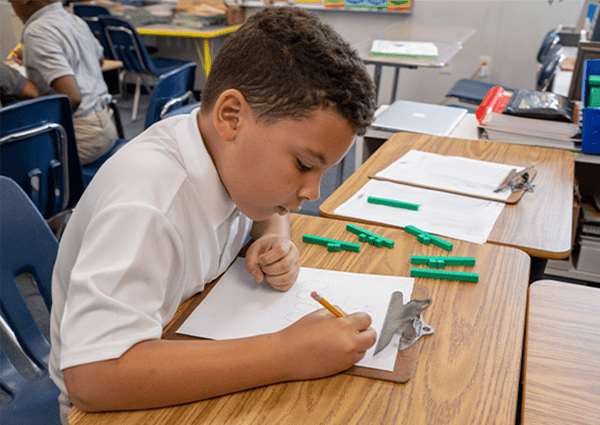When I was a kid, school and paper were practically synonymous. The smell of books, the crisp edge of a college-ruled spiral notebook, the satisfying cleanness of a perfectly folded note to my friend (certainly never passed during class)—paper was school and school was paper. I loved them both.
As a math teacher, my love of paper combined with the relative scarcity of laptops in my school community made print a staple of my classroom. But it wasn’t just my and my district’s idiosyncrasies that made paper a good choice. Here are 10 reasons why printed materials belong in math class.
1. Process thinking takes more working memory than most people have.
Doing math in your head is harder than writing it out because you have to hold so many pieces of information in your short-term memory at once. When you bump against the limits of your working memory, you lose bits of information. When students write down their work, they free up memory space to think about more complex ideas. Writing is the ancient, universal solution to the brain cramp.
2. Writing is good for thinking, and paper is good for writing.
Research shows that the act of writing by hand helps students synthesize and retain information better than typing. What better way to encourage students to write than by giving them printed materials to write on? Journaling has gained popularity in math class for good reason. When students write out their thinking processes, they understand more and are sometimes able to catch their own misconceptions.
3. Some accessibility tools are just plain better in print.
I’ve seen some helpful digital accessibility features for students who need added support, but there are a few that just can’t match what we can do with print materials. Take, for instance, colored overlays for students with scotopic sensitivity. Overlays can be a simple solution for kids who experience Irlen Syndrome, a processing discrepancy common for students with dyslexia.
4. Print materials can go anywhere you go (except maybe the shower).
Need to lie down? Work in the car? On a plane? In the yard? Books are good to go! No Wi-Fi? Want to sit upside down? No problem! Grab a clipboard, clip your worksheet to it, and put your feet in the air until you’re blue in the face.
5. Marginalia is like having a conversation with the text.
Writing in the margins is a time-honored way to quickly record pertinent thoughts in math. If you have an idea or question, you can write your thoughts next to the text or image that sparked it. In my class, I asked for sticky notes on the school supply list. We called them “think marks.” I loved seeing evidence of interactions with learning poking out of the print materials in class.
6. Printed materials are great for stickers and sticking on the fridge.
Never underestimate the power of praise. When students get back an A+ on a quiz, you can put a scratch-and-sniff sticker on it. Then they can take that paper home and display it with pride on the fridge. They can also put it in a scrapbook, mail it to less tech-savvy loved ones who want a chance to dote on them, or tuck it into a shoebox or folder to take out and enjoy in the future.
7. Print materials ensure more equal access for all students.
Since printed materials require basically no accessories or peripherals beyond a pencil (and maybe a clipboard if you’re fancy), they’re budget-friendly options for schools and families. Similarly, printed materials have almost no learning curve to use, never run out of batteries, and never need technical support to work as they should, removing barriers to using them.
8. Screen-free learning can help some students focus.
Some people—adults and children alike—find it nearly impossible to focus while using electronic devices. Providing students with printed materials gives them an opportunity to work without digital distractions.
9. It’s easier for students to communicate written mathematical ideas.
Have you ever tried to type out your work for an algebra problem? Unless you have lots of practice, a stylus, or special software, it can be incredibly frustrating to solve math problems or communicate mathematical ideas through word-processing or document apps. Trying to format an equation and solve it while learning to do both is harder than trying to do either separately. They’re separate skills for students to master. When students have printed materials, we remove the potential learning barrier.
10. It’s easier for teachers to give feedback.
Giving students clear feedback is one of the most important things teachers do, so getting it right is crucial. Just like students, educators can struggle with communicating their mathematical thinking via typing. Although many programs or apps come with built-in annotation tools that make it possible to comment on students’ work, they can be hard to use and can’t match the simple, precise, efficient action of jotting a quick note on a student’s work with a felt-tip pen.









